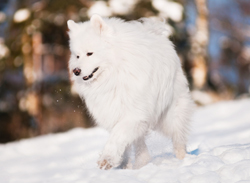The American Eskimo is known for its bright white fluffy coat with neck ruff and for its black nose, lips, and eye rims. The breed's plumed tail curls over its back, and its ears are triangular and erect. The outer coat consists of long, straight guard hairs, while the undercoat is made of short, dense hairs. The body is compactly built and the eyes are dark and alert.
They make great companion animals, are decent with children and other dogs, and are affectionate and loyal.
American Eskimos are intelligent, beautiful, and mischievous dogs. They make great companion animals, are decent with children and other dogs, and are affectionate and loyal. These dogs are friendly, but wary of strangers, and make great watchdogs.
The breed is divided into Toy, Miniature, and Standard size. The Toy measures 9 to 12 inches at the shoulder and typically weighs 7 to 10 pounds; the Miniature measures 12 to 15 inches and weighs 11 to 20 pounds; the Standard measures 15 to 19 inches at the shoulder and weighs 20 to 40 pounds. American Eskimos live up to 15 years when properly cared for throughout life.
American Eskimos are intelligent, alert, and friendly, and they make excellent companion animals. The breed is not known for being overly shy or aggressive. They are adaptable and affectionate and are protective of their home and family without being threatening or prone to biting. This makes them great watchdogs, especially in homes with children.
Eskies are best with older children because the breed tends to be impatient and can become irritated when hugged or pulled around. Although their size makes them ideal for small spaces, their tendency to bark a lot may be a problem in apartments. Frequent exercise and a lot of attention may help reduce barking, but the breed should ideally be housed in a single family home.
American Eskimos are a very sensitive breed and they dislike fighting among family members. Yelling and discord can lead to stress, anxiety, and behavior problems in these dogs.
Generally healthy, American Eskimos benefit from regular veterinary visits and dental checkups. The breed is at increased risk of pyruvate kinase deficiency, a disorder that can cause chronic anemia, and retinal atrophy, which causes blindness. Eskies are also prone to hip dysplasia, skin allergies, and flea allergies. Also, shaved dogs are at risk of sunburn.
Care must be taken to prevent overeating and obesity in the breed. Eskies need plenty of exercise and a carefully controlled diet to ensure they do not become overweight. Toy and Miniature American Eskimos benefit from a short daily walk and some free play each day. Standard American Eskimos should be taken for longer daily walks and need outdoor time to romp and run.
Routine veterinary care, vaccinations, regular exercise, and proper nutrition ensure American Eskimos live a full life of 12 to 15 years.
Because they are eager to please and learn quickly, American Eskimos are easy to train, provided training is done with patience and consistency. Positive reinforcement typically works best with this breed, and the fastest results are seen with praise, food, and play rewards. American Eskimos do not respond well to harsh punishment or manipulation.
The breed is vocal and is prone to barking. Without training, barking can quickly become a problem and the dog may be considered a nuisance by neighbors. Training early in life can reduce barking to a manageable level in most dogs. Daily exercise, which can include long walks, structured games, or free play in an enclosed yard, is also helpful.
Socializing Eskies will increase their tolerance of other dogs and of children and strangers. The breed is responsive to play and games and is very happy when given lots of attention. Behavior problems tend to occur when these dogs are left alone for considerable periods on a daily basis. Separation anxiety can also be a problem in American Eskimos.
The American Eskimo's thick double coat is fairly easy to manage but is prone to shedding during warmer months. Grooming must focus on both layers of the breed's coat to prevent problems. Trimming is rarely necessary, although some caretakers choose to shave the Eskie's coat during summer months for comfort.
Brush the coat a few times each week to prevent and remove tangles and mats. Brush more often when shedding to minimize hair left on furniture and clothing. Proper grooming of an American Eskimo requires a pin brush, slicker brush, and metal Greyhound comb. Uncooperative Eskies may need to see a professional groomer, but this breed is usually tolerant of brushing and combing.
The breed needs bathing only every few months or as needed to remove oil, grease, or other substances. The nails should be trimmed every two to three weeks, and the teeth require frequent brushing to prevent tartar buildup. With regular attention and routine care, the coat, teeth, and nails are not prone to significant problems.
American Eskimos, or Eskies, belong to the Spitz family and are descended from European Spitzes, such as the white Keeshond, German Spitz, Italian Spitz, and Pomeranian. Records are limited, but the first American Eskimo probably came to the United States from Europe in the early 1900s.
Eskies were bred by German immigrants in the United States in the 19th century because of their beauty, nimbleness, and trainability. The breed was a common site in traveling circuses all across the country during the 1900s. They were huge hits performing dog tricks and stunts and were sometimes given away as circus prizes.
Until 1917, the American Eskimo was called the American Spitz. In recent years, American Eskimos have become extremely popular companion animals and show dogs.
The American Kennel Club officially recognized the American Eskimo in 1994.

